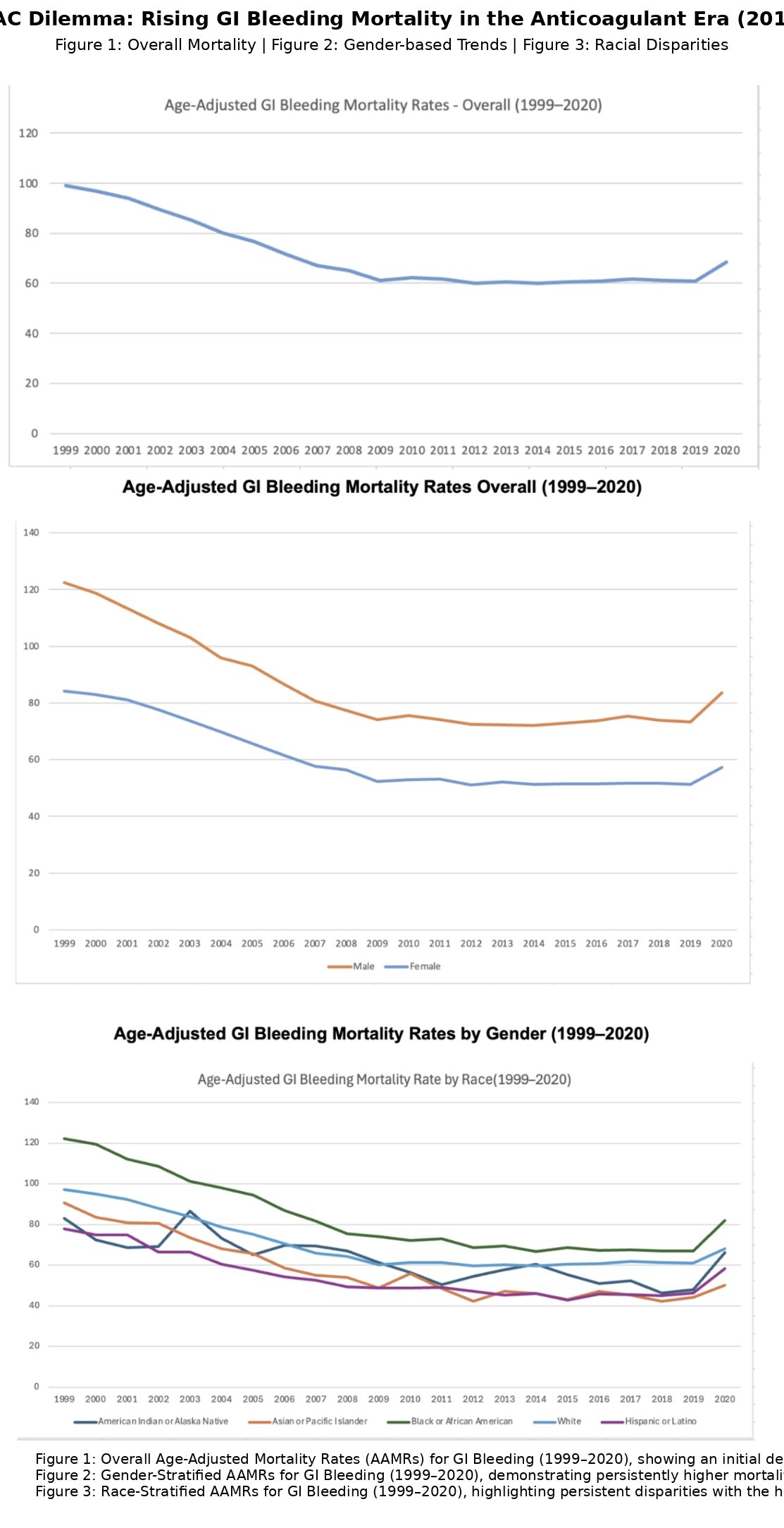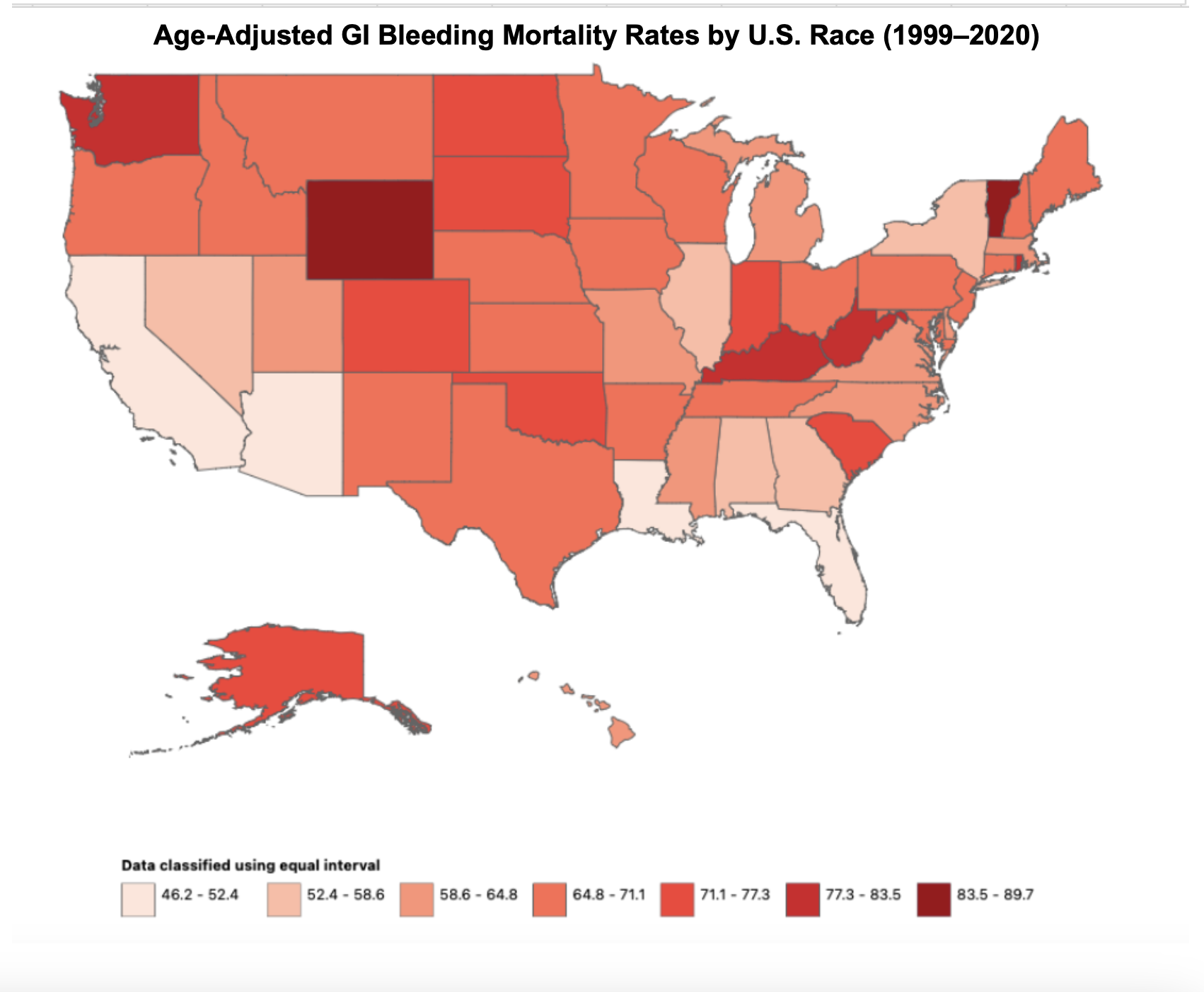Sunday Poster Session
Category: GI Bleeding
P0928 - The DOAC Dilemma: Rising GI Bleeding Mortality in the Anticoagulant Era
Sunday, October 26, 2025
3:30 PM - 7:00 PM PDT
Location: Exhibit Hall

Rahul Kumar, MD (he/him/his)
North Central Bronx Hospital
Bronx, NY
Presenting Author(s)
Rahul Kumar, MD1, Avinash Nankani, MBBS2, Syeda Ayesha Ali, MBBS2, Sunny Kumar, MD3, Diksha Kajal, MD4, Fnu Arti, MD5, Karan J.. Yagnik, MD6, Donald P. Kotler, MD7
1North Central Bronx Hospital, Bronx, NY; 2Dow University of Health Sciences, Karachi, Sindh, Pakistan; 3Wright Center for Graduate Medical Education, Scranton, PA; 4Florida State University, Cape Coral, FL; 5Saint Francis Medical Center, Monroe, LA; 6Monmouth Medical Center, Robert Wood Johnson Medical School of Rutgers University, Long Branch, NJ; 7NYC Health + Hospitals/Jacobi, Bronx, NY
Introduction:
Gastrointestinal (GI) bleeding remains the most unpredictable and deadliest complication, accounting for over 1.5 million healthcare visits [1] and approximately 500,000 hospitalizations annually [2]. Our study aims to assess the temporal trends in GI bleeding-related mortality among older US citizens ( >65) by sex, race, census and state over two decades, coinciding with the rise in Direct Oral Anticoagulant Usage (DOAC).
Methods:
Methods:
We utilized CDC WONDER database to determine the age-adjusted mortality rates (AAMR) of GI bleed in the US population from 1999-2020. AAMRs per 100,000 people were extracted. The trends were calculated by the Joinpoint Regression Program, which reported the annual percent changes (APC) and average annual percent change (AAPC) using the Monte Carlo Permutation test. We used the parametric test to estimate a 95% confidence interval. Trend comparison was analyzed by parallelism test, with a p-value < 0.05 indicating statistically significant results.
Results:
Results:
From 1999-2020, 644,424 GI bleeding-related deaths were reported among adults aged ≥65 in the US. AAMR declined from 99 in 1999 to 59.9 in 2012, then rose sharply to 68.6 in 2020. Males consistently exhibited higher AAMRs than females (APC 2018-20: 6.04 vs 5.21). By race, Black adults showed the highest AAMR (81.3), followed by Whites (68.1) and American Indians (60.1). Regionally, the South led in mortality (APC 2018-20: 6.96), compared to the Northeast (-0.27), Midwest (6.25), and West (5.30). California reported the most deaths (60,603), followed by Texas. Joinpoint analysis showed significant trend reversals post-2012 across subgroups. These shifts coincided with DOAC uptake during the same period. While earlier years reflected declining mortality, recent years suggest a potential association between anticoagulant usage and resurgence in GI bleeding-related deaths.
Discussion:
Discussion:
This study represents a rare national analysis linking a drug class, DOACs, to shifting mortality trends in GI bleeding among older adults. After a prolonged period of decline, mortality began to rise during the same period in which DOACs use became widespread, notably among Hispanic populations and women. These findings parallel the RHEDAR study, which demonstrated higher GI bleed risk with anticoagulants regardless of their type [3]. These demographic disparities highlight the need for risk-adjusted prescribing and improved healthcare access for patients on anticoagulant therapy.

Figure: Figure 1: Overall Age-Adjusted Mortality Rates (AAMRs) for GI bleeding (1999–2020), showing an initial decline, plateau in the 2010s, and a rise in 2020.
, Gender-stratified AAMRs for GI bleeding (1999–2020), with males experiencing consistently higher mortality rates than females.
and Race-stratified AAMRs for GI bleeding (1999–2020), demonstrating persistent disparities, with the highest mortality observed among Black or African American individuals.

Figure: Figure 2: Geographic distribution of age-adjusted GI bleeding mortality rates across the United States (1999–2020). States in the Appalachian and Southern regions exhibit the highest mortality rates, while several Western states demonstrate comparatively lower rates. Data are stratified by equal intervals to highlight regional disparities.
Disclosures:
Rahul Kumar indicated no relevant financial relationships.
Avinash Nankani indicated no relevant financial relationships.
Syeda Ayesha Ali indicated no relevant financial relationships.
Sunny Kumar indicated no relevant financial relationships.
Diksha Kajal indicated no relevant financial relationships.
Fnu Arti indicated no relevant financial relationships.
Karan Yagnik indicated no relevant financial relationships.
Donald Kotler indicated no relevant financial relationships.
Rahul Kumar, MD1, Avinash Nankani, MBBS2, Syeda Ayesha Ali, MBBS2, Sunny Kumar, MD3, Diksha Kajal, MD4, Fnu Arti, MD5, Karan J.. Yagnik, MD6, Donald P. Kotler, MD7. P0928 - The DOAC Dilemma: Rising GI Bleeding Mortality in the Anticoagulant Era, ACG 2025 Annual Scientific Meeting Abstracts. Phoenix, AZ: American College of Gastroenterology.
1North Central Bronx Hospital, Bronx, NY; 2Dow University of Health Sciences, Karachi, Sindh, Pakistan; 3Wright Center for Graduate Medical Education, Scranton, PA; 4Florida State University, Cape Coral, FL; 5Saint Francis Medical Center, Monroe, LA; 6Monmouth Medical Center, Robert Wood Johnson Medical School of Rutgers University, Long Branch, NJ; 7NYC Health + Hospitals/Jacobi, Bronx, NY
Introduction:
Gastrointestinal (GI) bleeding remains the most unpredictable and deadliest complication, accounting for over 1.5 million healthcare visits [1] and approximately 500,000 hospitalizations annually [2]. Our study aims to assess the temporal trends in GI bleeding-related mortality among older US citizens ( >65) by sex, race, census and state over two decades, coinciding with the rise in Direct Oral Anticoagulant Usage (DOAC).
Methods:
Methods:
We utilized CDC WONDER database to determine the age-adjusted mortality rates (AAMR) of GI bleed in the US population from 1999-2020. AAMRs per 100,000 people were extracted. The trends were calculated by the Joinpoint Regression Program, which reported the annual percent changes (APC) and average annual percent change (AAPC) using the Monte Carlo Permutation test. We used the parametric test to estimate a 95% confidence interval. Trend comparison was analyzed by parallelism test, with a p-value < 0.05 indicating statistically significant results.
Results:
Results:
From 1999-2020, 644,424 GI bleeding-related deaths were reported among adults aged ≥65 in the US. AAMR declined from 99 in 1999 to 59.9 in 2012, then rose sharply to 68.6 in 2020. Males consistently exhibited higher AAMRs than females (APC 2018-20: 6.04 vs 5.21). By race, Black adults showed the highest AAMR (81.3), followed by Whites (68.1) and American Indians (60.1). Regionally, the South led in mortality (APC 2018-20: 6.96), compared to the Northeast (-0.27), Midwest (6.25), and West (5.30). California reported the most deaths (60,603), followed by Texas. Joinpoint analysis showed significant trend reversals post-2012 across subgroups. These shifts coincided with DOAC uptake during the same period. While earlier years reflected declining mortality, recent years suggest a potential association between anticoagulant usage and resurgence in GI bleeding-related deaths.
Discussion:
Discussion:
This study represents a rare national analysis linking a drug class, DOACs, to shifting mortality trends in GI bleeding among older adults. After a prolonged period of decline, mortality began to rise during the same period in which DOACs use became widespread, notably among Hispanic populations and women. These findings parallel the RHEDAR study, which demonstrated higher GI bleed risk with anticoagulants regardless of their type [3]. These demographic disparities highlight the need for risk-adjusted prescribing and improved healthcare access for patients on anticoagulant therapy.

Figure: Figure 1: Overall Age-Adjusted Mortality Rates (AAMRs) for GI bleeding (1999–2020), showing an initial decline, plateau in the 2010s, and a rise in 2020.
, Gender-stratified AAMRs for GI bleeding (1999–2020), with males experiencing consistently higher mortality rates than females.
and Race-stratified AAMRs for GI bleeding (1999–2020), demonstrating persistent disparities, with the highest mortality observed among Black or African American individuals.

Figure: Figure 2: Geographic distribution of age-adjusted GI bleeding mortality rates across the United States (1999–2020). States in the Appalachian and Southern regions exhibit the highest mortality rates, while several Western states demonstrate comparatively lower rates. Data are stratified by equal intervals to highlight regional disparities.
Disclosures:
Rahul Kumar indicated no relevant financial relationships.
Avinash Nankani indicated no relevant financial relationships.
Syeda Ayesha Ali indicated no relevant financial relationships.
Sunny Kumar indicated no relevant financial relationships.
Diksha Kajal indicated no relevant financial relationships.
Fnu Arti indicated no relevant financial relationships.
Karan Yagnik indicated no relevant financial relationships.
Donald Kotler indicated no relevant financial relationships.
Rahul Kumar, MD1, Avinash Nankani, MBBS2, Syeda Ayesha Ali, MBBS2, Sunny Kumar, MD3, Diksha Kajal, MD4, Fnu Arti, MD5, Karan J.. Yagnik, MD6, Donald P. Kotler, MD7. P0928 - The DOAC Dilemma: Rising GI Bleeding Mortality in the Anticoagulant Era, ACG 2025 Annual Scientific Meeting Abstracts. Phoenix, AZ: American College of Gastroenterology.
